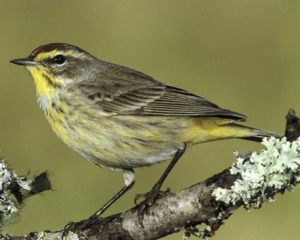This week is all about songbirds! There are many other songbirds in Central Florida you can identify, but here are a few we can practice this week. Have you been following along with our weekly Bird Watching Series? I hope you were able to identify one new woodpecker outside last week. If you missed it last week’s Woodpeckers post, click here. This week, we will be learning about “Songbirds”. These birds can be seen in agricultural environments, hardwood swamps, hammocks, pine flatwoods, mixed forests, open woodlands, sandhills, fresh and saltwater marshes, and even in suburban areas. Grab your binoculars and go exploring with us!
Bird watching is an activity that is ageless – anyone can learn and appreciate the wonderous bird species. All you need are a pair of binoculars. Let us know if you can spot and identify one of these Songbirds this week!
Blue Jay
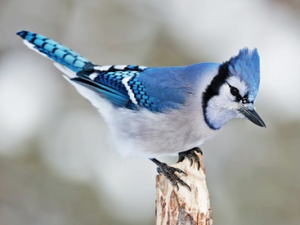
Habitat:
- Resides in much of the eastern 2/3 of the United States and Canada.
- Florida’s permanent resident
- Agricultural environments, hardwood swamps, hammocks, pine flatwoods, mixed forests, and sandhills
- Human activities have benefitted the Blue Jay by creating more woodland edge, and it has successfully adapted to suburban areas
Diet:
- Acorns and other seeds or nuts
- First select the sunflower seeds from a birdseed mixture
- Insects, lizards, toads, rodents, bird eggs, and nestlings
Nesting:
- Bulky nest is placed 10 to 40 ft. up in a tree
- Twigs, pine needles, Spanish moss, paper, and other debris
- Clutch size: 4-5 eggs (greenish, bluish, or buffy with brown spots)
*Note: Intelligent and adaptable, it may feed on almost anything, and it is quick to take advantage of bird feeders. Blue Jays make a variety of musical sounds. The Blue Jay also has a reputation as a raucous, aggressive bully, who robs other birds’ nests.
Click here for more information.
Florida Scrub-Jay
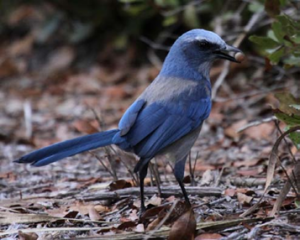
Habitat:
- The only species of bird that is unique to Florida
- Sand pine and xeric (very dry) oak scrub, and scrubby flatwoods
- Ancient sandy ridges that run down the middle of the state, old sand dunes along the coasts, and sandy deposits along rivers in the interior of the state
Diet:
- Insects, frogs, toads, lizards, mice, bird eggs, and acorns
Nesting:
- Live in family groups that consist of a breeding pair and their offspring
- Breeding at 2-3 years old (continue their lifetime)
- Short breeding season
- Nests are made from twigs and palmetto fibers
- Built 3 -10 feet off of the ground in scrubby oaks
- Clutch size: 3-4 eggs (light green, olive or brown spots)
*Note: The Florida scrub-jay is protected by the U.S. Migratory Bird Treaty Act. It is also protected as a Threatened species by the Federal Endangered Species Act and as a Federally-designated Threatened species by Florida’s Endanger and Threatened Species Rule.
Click here for more information.
Red-Winged Blackbird
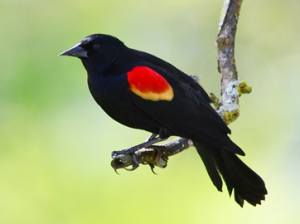
Habitat:
- Fresh & saltwater marshes, along watercourses, water hazards on golf courses, and wet roadsides, as well as drier meadows and old fields
- Winter: crop fields, feedlots, and pastures
Diet:
- Insects, spiders, and other invertebrates
- Other times of the year, weed seeds and crop grains
- Known to forage in rice fields and other croplands
Nesting:
- Placed in marsh growth such as cattails or bulrushes, in bushes or saplings close to water, or in dense grass in fields
- Nest is bulky open cup, lashed to standing vegetation, made of grass, reeds, leaves, rootlets, lined with fine grass
- Clutch size: 3-4 eggs (pale blue-green with black, blue, or purple markings)
*Note: Male Red-winged Blackbirds are hard to mistake, with an even glossy black with red-and-yellow shoulder badges). Females are crisply streaked and dark brownish overall, paler on the breast and often show a whitish eyebrow.
Click here for more information.
Carolina Wren
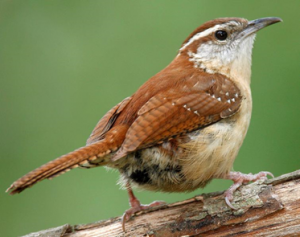
Habitat:
- Dense vegetation in wooded areas, forest ravines, and neighborhoods
- Move through tangled understory
- Backyard brush piles and areas choked with vines and bushes
Diet:
- 94% of diet is animal based
- Insects, spiders, caterpillars, moths, flies, grasshoppers, crickets, bees, and aquatic insects from driftwood
Nesting:
- Open cavities 3–6 feet off the ground, in trees, overhangs and stumps
- 1st nests: Built on vegetation-shaded ground, discarded flowerpots, mailboxes, propane-tank covers, and other items (old coats and boots)
- May mate for life; pairs are together all year
- Clutch size: 5-6 eggs (white, with brown blotches)
Click here for more information.
Palm Warbler
Habitat:
- Open woodlands
- Breeds in bogs and areas with scattered evergreen trees and thick ground cover in the boreal forest
Diet:
- Insects (beetles, flies, caterpillars), seeds, and berries
Nesting:
- On the ground nestled in peat moss, at the base of a small tree or shrub
- Occasionally nest on or slightly above the ground in drier evergreen forests
- Clutch size: 4-5 eggs (creamy white with brown marks)
Click here for more information.
Be sure to share with us birds that you have spotted in your yards, parks, and in your community!
 0
0
